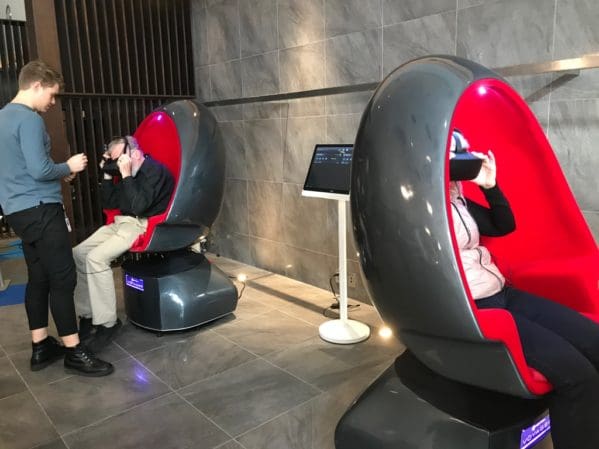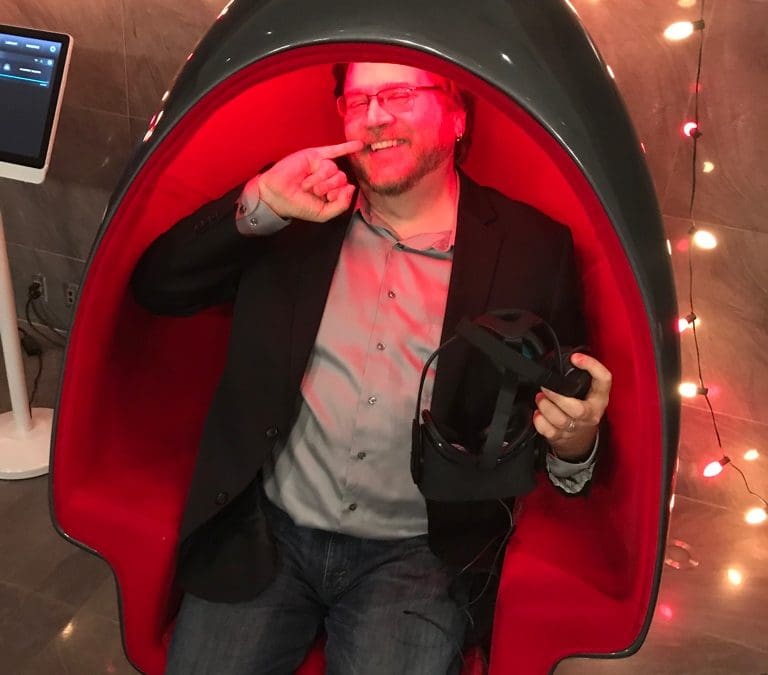What are the design rules in an environment where literally anything is possible?
More than a year ago, Technicolor Labs, a super-cool space located in the Blackwelder Arts district of Culver City, invited the ever-insightful game designer Ed Moore and myself to come in for a conversation about the challenges & opportunities offered by Virtual Reality. 
The Technicolor Labs space was dedicated to exploring the latest tools, techniques and creations made possible by Virtual Reality and Augmented Reality technology.
One of my favorites is these “Dr. Evil” chairs – they have speaker embedded in the backs, and they tilt & spin around to give you a physical sensation that goes along with the visual and audio programming. It’s particularly effective for space-based or underwater environments, because it can make you feel like you’re floating gently.
The one limitation I found was that because I am so tall, I keep bumping my head against the roof of the egg, and I think I heard the gears grinding a bit as it tried to adjust for my size. But still, it does provide a real immersive experience, although I think it still much better suited for flying games, where you’re trying to shoot down enemy planes or fight off waves of dragons or some such.
And yes, I did have to pose like Dr. Evil upon entering into this damn thing.
A t any rate, Ed & I sat for this interview, and tried to explain what we see as the issues that are going to have to be solved before we can make working or playing in VR into something that works for the ordinary person.
t any rate, Ed & I sat for this interview, and tried to explain what we see as the issues that are going to have to be solved before we can make working or playing in VR into something that works for the ordinary person.
One of the key issues is navigation.
You’re probably so used to it by now, you don’t really think about how you navigate around the web. You click, or swipe or tap or mouse, or use CMD+arrow to move around. It’s become so common now, it’s hard to remember what a revolution it was to use a mouse to be able to do stuff on computers.
Yes, I’m going there. All the way back to MS-DOS 5.0, which was the first version that had even rudimentary mouse support. Before that, you had to work with the command prompt – the dreaded C:\\___ where you had to type in commands you had memorized like mdir or chkdisk/f to try to get your stubborn PC-AT to load programs, move files, or fix itself in the not uncommon circumstances when it broke down.
But what do you do in a world where there are perhaps no keyboard or mice? Do we use our fingers to point? Or just glare at things and nod? Or voice command?
There are flaws with all of these interfaces, but my prediction is that the next few years, as we all adjust to our involuntary confinement because of COVID-19, we are going to see a resurgence of interest in Virtual Reality. It’s going to offer us a sense that we’re not locked into our homes, not limited to those few square feet where we can walk, talk and eat without facing existential peril.
Special bonus: at about 5 minutes in, I am the first to go for the “blue material” and mention the word “teledildonics.”

